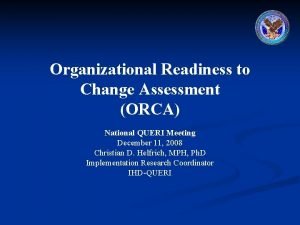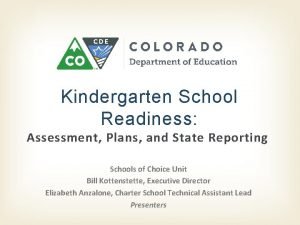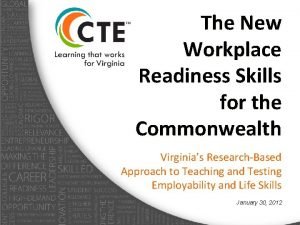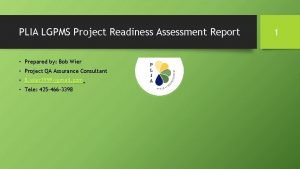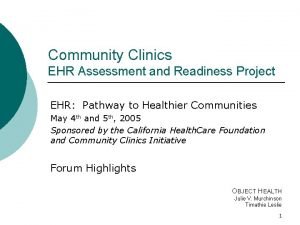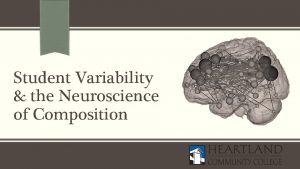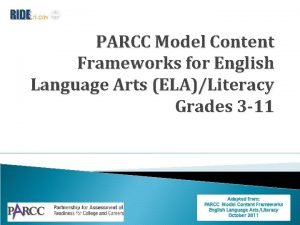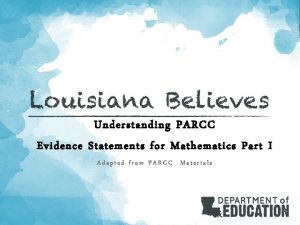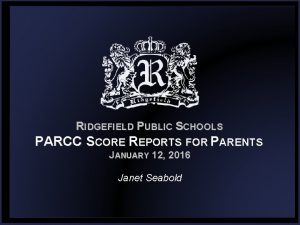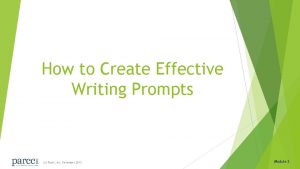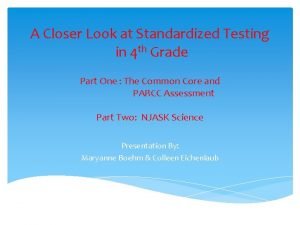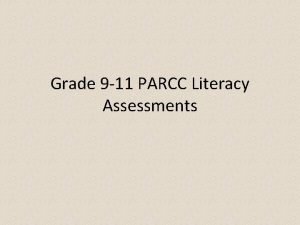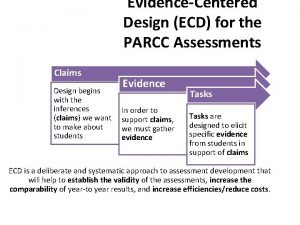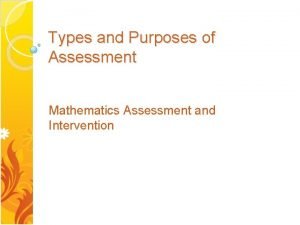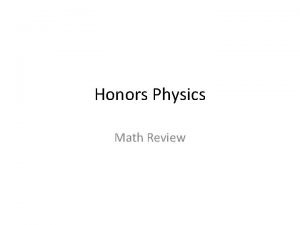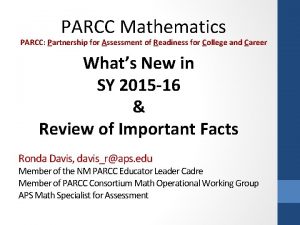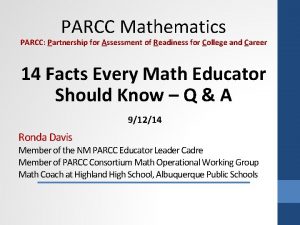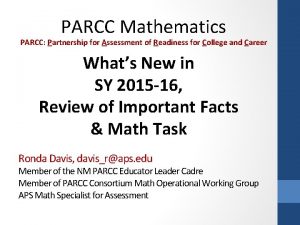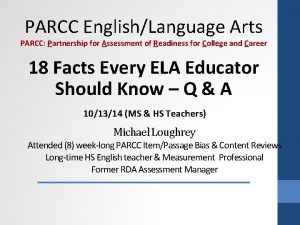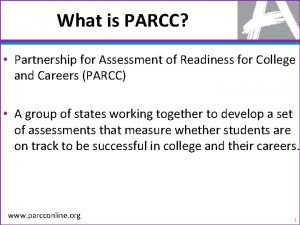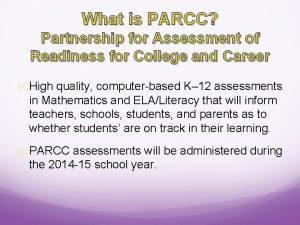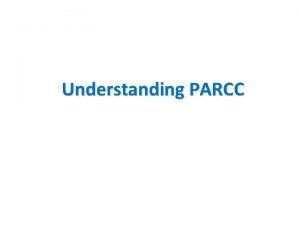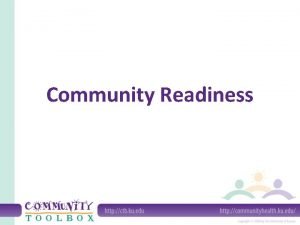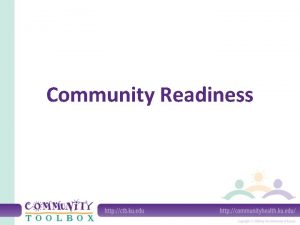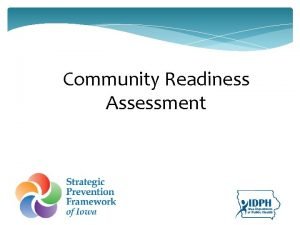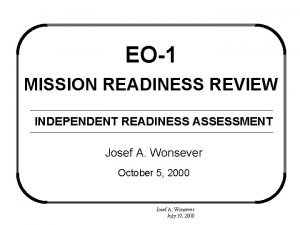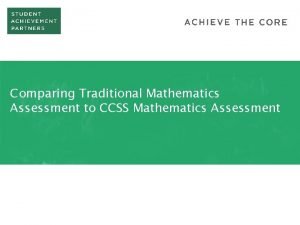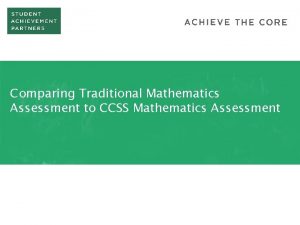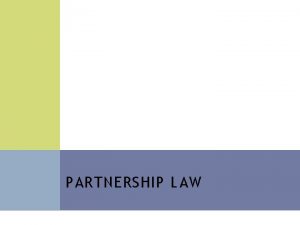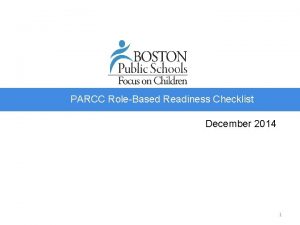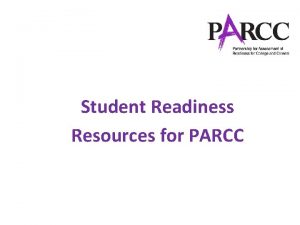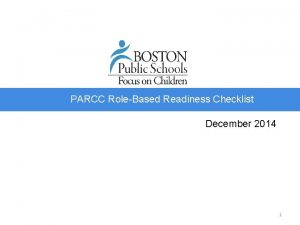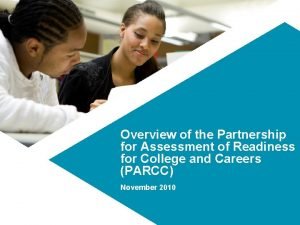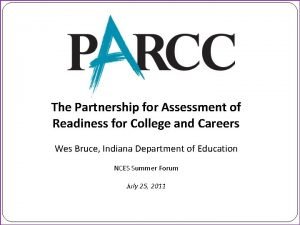PARCC Mathematics PARCC Partnership for Assessment of Readiness




































- Slides: 36

PARCC Mathematics PARCC: Partnership for Assessment of Readiness for College and Career 14 Facts Every Math Educator Should Know – Q & A 9/12/14 Ronda Davis Member of the NM PARCC Educator Leader Cadre Member of PARCC Consortium Math Operational Working Group Math Coach at Highland High School, Albuquerque Public Schools

Objective • I will get all my current questions about PARCC answered

#1 PARCC replaces the SBA this Year


April 13 – May 8 For this year’s testing, results will not be available until Fall, 2015

#2: Students Test By Content – Not Necessarily Grade Level Grades 3 – 8: Take the Test Based on their Enrolled Grades 6 – 12: Take the Test Based on their Enrolled Class • Algebra 1 • Geometry • Algebra 2

#3: Scoring • Scoring Will Be Based on Student Work for Hand Scored Items (PBA) • Scoring Will Be Based on Correct Work for Machine Scored Items (EOY & PBA)

Samples of Scoring & Technology Enhancements • Both PBA & EOY will have: § equation editor • All constructed response will appear on PBA ØFree Response on EOY & PBA (machine-scored)

Multiple Select: 6 th Grade Example

Hotspots: From Algebra 1

In-Line/Drop Down Menus: From Geometry

Drag-and-Drop: From 8 th Grade

Fill-In-The-Blank: From 7 th Grade

Equation Editor: From 7 th Grade EOY

#4 Accessibility & Accommodations Support , Line Reader Tool

Accessibility Features Identified In Advance • Since reading is not the construct being tested on the math, ALL students can have access to Ø Text to Speech Through the Use of Headphones Ø Does NOT require IEP, 504 or ELL plan Ø Should be determined by parents, students and teacher

#5: Calculator Use • Grades 3 – 5 – No Calculators • Grades 6 – 7: Four Function with Square Root & % • Grade 8: Scientific Calculator • Algebra 1, Geometry, Algebra 2: Graphing Calculator

Grades 6 - 12 Drop Down Calculators Additionally, Students will be allowed to bring their own calculators. (No qwerty or CAS) scientific calculator (Grade 8) Grades 3 – 5 No Calculator Grades 6 – 7: Four Function with % and square root key

#6: Math Tools • On-Line Grades 4 - 12: • Rulers & Protractors available as on-line tools (shown to the right) • 8 th Grade, Geometry & Integrated Math: • Not Provided as On-Line Tools, but. . . Ø Schools or Students May Provide: tracing paper, reflection tools, straight edge and compass – think Transformational Geometry Tools

#7 – Scratch Paper • Test Administrators Must Provide: ØAt least 2 sheets of blank paper or graph paper test/session (unit) ØScratch paper is NOT limited

#8: Reference Sheets • Think about how to incorporate these into your instruction • Will be provided as a dropdown ØHard copies may be provided as well




#9: Evidence-Centered Design (ECD) Claims ECD is a deliberate and systematic approach to assessment development that will help to establish the validity of the assessments, increase the Evidence comparability of year-to year results, and increase efficiencies/reduce costs. Tasks Design begins with the inferences (claims) we want to In order to support Tasks are designed make about claims, we must to elicit specific students gather evidence from students in support of claims ECD is a deliberate and systematic approach to assessment development that will help to establish the validity of the assessments, increase the comparability of yearto year results, and increase efficiencies/reduce costs.

Claims Structure: Mathematics Master Claim: On-Track for college and career readiness. The degree to which a student is college and career ready (or “ontrack” to being ready) in mathematics. The student solves grade-level /course-level problems in mathematics as set forth in the Standards for Mathematical Content with connections to the Standards for Mathematical Practice. Sub-Claim A: Major Content 1 with Connections to Practices The student solves problems involving the Major Content 1 for her grade/course with connections to the SMP’s ~43% ~37 pts (3 -8), ~42 pts (HS) Sub-Claim B: Additional & Supporting Content 2 with Connections to Practices The student solves problems involving the Additional and Supporting Content 2 for her grade/course with connections to the SMP’s. ~24% ~14 pts (3 -8), ~23 pts (HS) Sub-Claim D: Highlighted Practice MP. 4 with Connections to Content (modeling/application) The student solves real-world problems with a degree of difficulty appropriate to the grade/course by applying knowledge and skills articulated in the standards for the current grade/course (or for more complex problems, knowledge and skills articulated in the standards for previous grades/courses), engaging particularly in the Modeling practice, and where helpful making sense of problems and persevering to solve them (MP. 1), reasoning abstractly and quantitatively (MP. 2), using appropriate tools strategically (MP. 5), looking for and making use of structure (MP. 7), and/or looking for and expressing regularity in repeated reasoning (MP. 8). ~19% 12 pts (3 -8), 18 pts (HS) 6 pts (Alg II/Math 3 CCR) Sub-Claim C: Highlighted Practices MP. 3, 6 with Connections to Content 3 (expressing mathematical reasoning) The student expresses grade/courselevel appropriate mathematical reasoning by constructing viable arguments, critiquing the reasoning of others, and/or attending to precision when making mathematical statements. ~14% 14 pts (3 -8), 14 pts (HS) 4 pts (Alg II/Math 3 CCR)

#10 Evidence Statements Have Useful Clarifications

More Evidence Statement Samples • Ca EOY , and estimate solutions by graphing the equations. Solve simple cases by inspection. For example, 3 x + 2 y = 5 and 3 x + 2 y = 6 have no solution because 3 x + 2 y cannot simultaneously be 5 and 6. Alg 1 Calculate and interpret the average rate of change of a function (presented symbolically or as table) over a specified interval. Estimate the rate of change from a graph

#11 Securely Held Knowledge Geom

#12 C & D Claims are NOT explicitly found in the CCSSM document • Based on Reasoning and Modeling ØConnecting CCSS to applications and modeling § For example: Geom

#13 Practice Tests • http: //practice. parcc. testnav. com/# • Taking the tutorial and practice test is the best way to become more familiar with PARCC tools and functionalities • PBA Practice Tests will be released later this fall

Field Test Lesson Learned • Teachers NOT students press Exit at the End of the Test • Keyboarding Skills

#14 NMPARCC Results Will Have Meaning Beyond High School

Updates and more information wanderson@parcconline. org d p U C g r C o R e. A P lin r o on f p rcc u a ign p @parccplace parcconline. org Sign up for the PARCC Updates newsletter s e at S

Resources • Assessments: the Next Generation: (links to all PARCC practice items, smarter balance, & other good next gen sources) Øhttp: //nextgen. apps. sparcc. org/math • Basic PARCC implementation Videos: Øhttp: //www. marlboro. k 12. nj. us/curriculum. cfm? subpage=67284 § APS Assessment Information: Ø http: //apsassessment. wordpress. com

Q&A What specific support do you need for your next steps? ü Write your name, school & the specific request on a post -it and place it on the poster
 Employment readiness scale
Employment readiness scale Organizational readiness to change assessment (orca)
Organizational readiness to change assessment (orca) Colorado kindergarten readiness assessment
Colorado kindergarten readiness assessment Cloud readiness assessment report
Cloud readiness assessment report Business transformation readiness assessment
Business transformation readiness assessment Employment readiness scale assessment
Employment readiness scale assessment Workplace readiness skills
Workplace readiness skills Tasc readiness assessment
Tasc readiness assessment Project readiness assessment
Project readiness assessment Manufacturing readiness assessment
Manufacturing readiness assessment Atul mittal deloitte
Atul mittal deloitte Ehr readiness assessment
Ehr readiness assessment Tra
Tra Brain parts
Brain parts Career readiness self assessment
Career readiness self assessment Business transformation readiness assessment
Business transformation readiness assessment Win career readiness
Win career readiness Parcc model content frameworks
Parcc model content frameworks Parcc evidence statements
Parcc evidence statements Parcc scoring guide
Parcc scoring guide Parcc writing prompts
Parcc writing prompts What does parcc stand for
What does parcc stand for Parcc
Parcc Parcc evidence statements
Parcc evidence statements Definition assessment
Definition assessment Physics skills mathematics assessment answers
Physics skills mathematics assessment answers Iso 22301 utbildning
Iso 22301 utbildning Novell typiska drag
Novell typiska drag Tack för att ni lyssnade bild
Tack för att ni lyssnade bild Returpilarna
Returpilarna Varför kallas perioden 1918-1939 för mellankrigstiden?
Varför kallas perioden 1918-1939 för mellankrigstiden? En lathund för arbete med kontinuitetshantering
En lathund för arbete med kontinuitetshantering Särskild löneskatt för pensionskostnader
Särskild löneskatt för pensionskostnader Personlig tidbok för yrkesförare
Personlig tidbok för yrkesförare Sura för anatom
Sura för anatom Vad är densitet
Vad är densitet Datorkunskap för nybörjare
Datorkunskap för nybörjare

